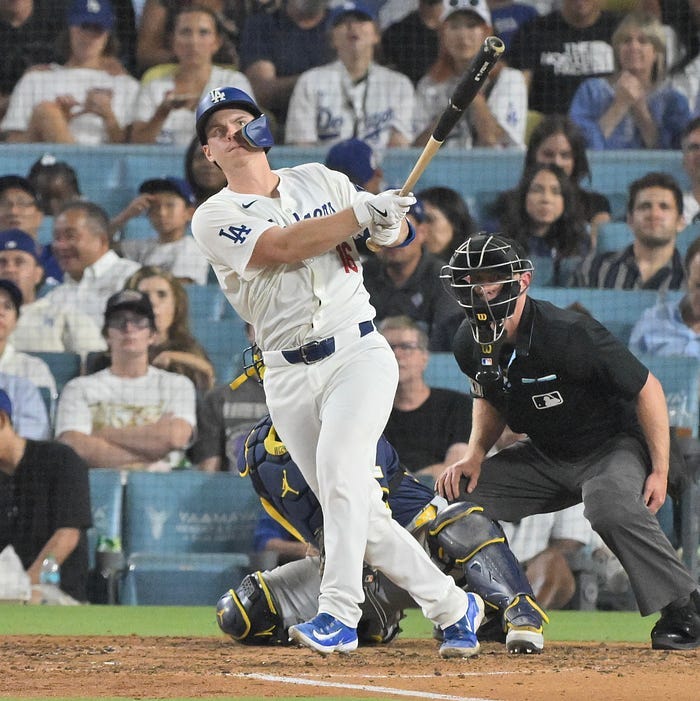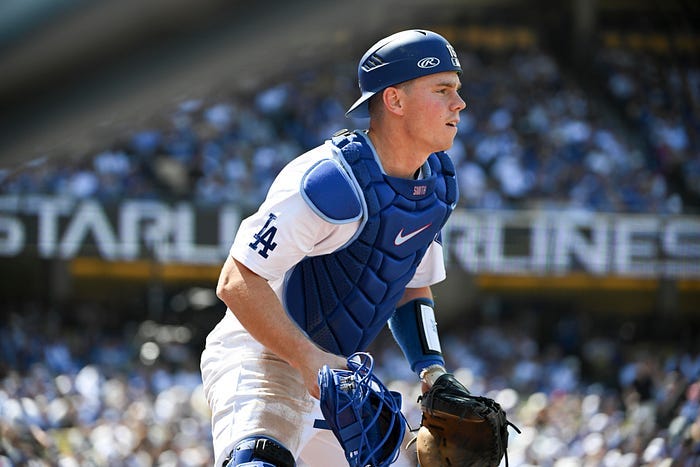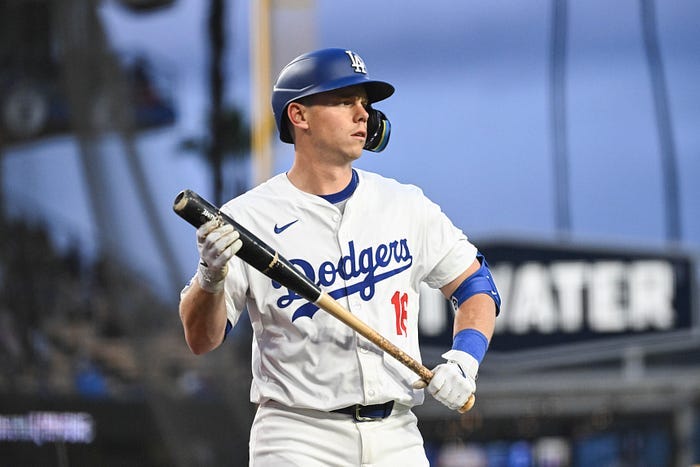
Editor’s Note: This story is from the pages of Dodger Insider magazine, 2024 Volume 6. Magazines are available at entry at parking stands at Dodger Stadium.
by Kyle Glaser
Inthe fall of 2016, the Dodgers approached their recent supplemental first-round pick with an unusual request. They wanted Will Smith to completely change his swing.
Smith, the 32nd overall pick in the 2016 draft, was firmly a contact hitter throughout his three-year college career at Louisville. With a short, descending swing path, Smith hit .291 with a .392 on-base percentage with nearly as many walks as strikeouts in his career with the Cardinals. He also hit nine home runs in three seasons.
The Dodgers, however, saw power potential and decided to try something radical.
Over the next three years, the Dodgers overhauled every component of Smith’s swing. Piece by piece, they implemented a new stance, a new load, a new leg kick, a new posture, a new bat path, a new finish and, ultimately, a new mindset.
The result was Smith transforming into one of the best-hitting catchers in baseball and one of the best power-hitting catchers in franchise history.
“I’m always the guy that wants to get better and learn and improve,” Smith says. “So yeah, I dove right into it. Luckily, I was surrounded by a lot of good coaches that know a lot of good stuff about hitting. I bought in and they’ve helped me really a lot.”

Smith hit three home runs on Friday night. (Jon SooHoo/Los Angeles Dodgers)
Today, Smith is one of the top offensive catchers in the game. Since making his big league debut in 2019 to midseason 2024, Smith leads all Major League catchers with an .841 OPS. He is one of just five players whose primary position is catcher with at least 100 home runs since 2019.
“That’s a testament to Will just really continuing to work and coming into his own,” says Brandon Gomes, Dodger executive vice president and general manager.
When the process of changing Smith’s swing began, the first step was altering Smith’s load to get his bat in a different position before moving forward. The ultimate goal was to re-route Smith’s bat path to get him to hit up on the ball more and get it in the air, as opposed to his previously descending bat path.
The process was far from smooth. After having one swing his entire amateur career and being successful with it, Smith struggled to get comfortable with the new ways his body was working.
In his first full professional season, Smith hit .232 at High-A Rancho Cucamonga — the second-lowest batting average on the team among starters — and saw his strikeout rate more than triple from his previous year in college. His home runs increased marginally, going from seven the previous year at Louisville to 11 at Rancho Cucamonga.
Smith admits it was frustrating at times. Still, he never wavered in his commitment to the process.
“It was just learning how to deal with it,” Smith says. “That’s baseball. There’s ups and downs. You’re constantly trying to fight something, trying to figure something out, trying to make an adjustment. That’s just baseball.”
Dodgers player development officials weren’t worried. They knew Smith’s swing was far from a finished product, and that they had merely layered on the first part of what would be a multi-step process.
“He just approached it in a really methodical way where you could see his swing improving,” says Will Rhymes, now the Dodger vice president of player development. Smith was in his third Minor League season when Rhymes became the Dodgers’ assistant farm director.
“You would see these glimpses of it coming together, and I think that it definitely gave us confidence to know that we were on track with some of these moves. It’s just a matter of consistency.”
The next step was adjusting Smith’s posture and leg kick. Smith previously hunched over in his stance and barely picked his foot up off the ground. The Dodgers stood him more upright and increased the height of his leg kick so that his knee was nearly parallel to his belt.
Combined with the previously adjusted load and resulting bat path, Smith’s power began to increase. He hit .233 between Double-A Tulsa and Triple-A Oklahoma City in 2018 and again saw his strikeout rate increase, but he hit 20 home runs in 98 games — a sign he was on the right track.
“The focus was on getting it the air, really drive it, but to do it properly,” Smith says. “It wasn’t just about hitting it in the air. A lot more went into it than that.”
The last step came during 2019 Spring Training. The Dodgers lowered Smith’s hands so they began at his chest rather than above his shoulder and added a higher finish to his swing. The effect was to cement a more uphill bat path and help Smith stay through the ball better as he elevated.

(Carrie Giordano/Los Angeles Dodgers)
With the final steps in place, everything clicked. Smith hit a career-high .268 at Oklahoma City and hit 20 home runs in only 62 games in 2019. He received his first big league callup that year and promptly hit 15 more home runs in only 54 games while taking over as the Dodgers’ everyday catcher.
It’s a position he has held while emerging as one of the best offensive catchers in baseball.
“I think it’s a great developmental story of this is what the Minor Leagues are for,” Rhymes says. “It’s not necessarily always about the stat line. It’s about what’s going on behind the scenes. And he was in the process for three years of building a really dynamic swing.”

(Jon SooHoo/Los Angeles Dodgers)
The Dodgers entered the 2024 season with a fearsome lineup topped by three Most Valuable Player award winners in Mookie Betts, Shohei Ohtani and Freddie Freeman.
As they constructed the Majors’ most dangerous offense, there was never a question in their mind who they wanted batting cleanup behind their three MVPs to begin the year: Smith.
“He’s really developed into an elite hitter,” says manager Dave Roberts. “He can hit to all fields. He takes a walk. He controls the strike zone. He’s just a very dependable hitter. He’s very cool under pressure. Doesn’t panic. I just can’t see a better guy to hit behind those first three guys, really.”
Indeed, Smith has flourished in the cleanup spot behind the Dodgers’ MVP trio. He leads all National League catchers in home runs (14), RBI (51), slugging percentage (.498), OPS (.852), Fangraphs Wins Above Replacement (3.3) and weighted runs created plus (138). He’s the MLB leader among catchers in slugging, OPS, fWAR and wRC+.
For Smith to become such an offensive force in the Major Leagues wasn’t a sure thing coming out of college. But his work helped make him that. The Dodgers thought so highly of his past and potential that they signed him to a 10-year contract on March 27. He is now one of four Dodgers all time whose primary position is catcher, with 100 home runs with the club, joining Roy Campanella (242), Mike Piazza (177) and Steve Yeager (100). Smith hit №100 on May 29 in New York against the Mets.
And after Friday night, he is one of four Dodger catchers all time with a three-home run game, joining Hall of Famers Roy Campanella and Mike Piazza and Yasmani Grandal.
“It’s kind of fun to look back at those old swings,” Smith says. “You don’t really even recognize it. But I’m glad I bought into it. Obviously, it’s worked out pretty good for me.”
From Dodger Insider magazine: Sweet-Swinging Will Smith was originally published in Dodger Insider on Medium, where people are continuing the conversation by highlighting and responding to this story.